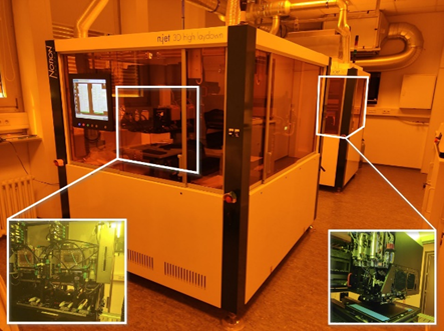3D Micro Printing (MP)
Nano to Micro/Macro (3D shaping)
3D Microprinting opens up a wide range of possibilities for the realization of freeform 3D structures with micrometer resolution features. Recent developments allow for a wide range of materials to be processed, from pure polymers to polymer-based highly filled composites for creating functionality enhanced 3D parts.
In the fused filament fabrication (FFF) process, the material of choice is provided as a filament that is melted in a hot chamber, extruded through a nozzle and selectively deposited on the building platform layer by layer of a predefined thickness. Modern 3D FFF printers with dual or multiple extrusion nozzles are utilized to print multi-material parts in one manufacturing process. This enables synergistic integration of different properties (e.g. flexibility, strength, electric conductivity, bio-degradability and color) to produce multi-functional parts without the need for a complex process chain of conventional manufacturing processes.
In inkjet printing, on-demand small and uniform droplets of different UV curable ink are precisely ejected from multiple printhead nozzles at high frequencies, employing either piezoelectric or thermal mechanisms. Multi-material can be jetted onto a wide range of substrates on which fired droplets instantly coalesce together to form one layer to be UV cured, and repeating this process enables the production of multi-material functional components with intricate features of micro-scale resolution.
Together these processes contribute towards the creation of innovative new components and products that possess inherent functionality and contain the benefit that they don’t require multiple process steps and additional supply chains. Thereby apart from increasing the innovation capacity, 3D microprinting also contributes towards enabling green manufacturing.



